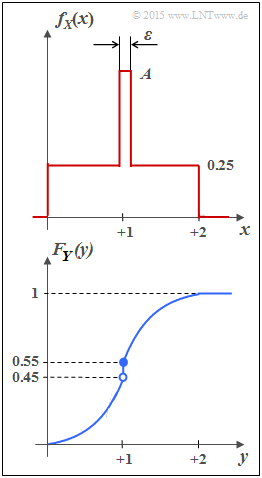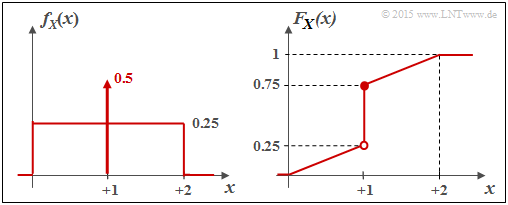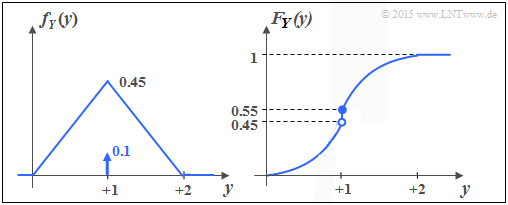Difference between revisions of "Aufgaben:Exercise 4.2Z: Mixed Random Variables"
| Line 3: | Line 3: | ||
}} | }} | ||
| − | [[File:P_ID2868__Inf_Z_4_2_neu.png|right|frame| | + | [[File:P_ID2868__Inf_Z_4_2_neu.png|right|frame|PDF of $X$ (top), and <br>CDF of $Y$ (bottom)]] |
| − | + | One speaks of a "mixed random variable", if the random variable contains discrete components in addition to a continuous component. | |
| − | * | + | *For example, the random variable $Y$ with [[Theory_of_Stochastic_Signals/Verteilungsfunktion|cumulative distribution function]] $F_Y(y)$ as shown in the sketch below has both a continuous and a discrete component. |
| − | * | + | *The [[Theory_of_Stochastic_Signals/Wahrscheinlichkeitsdichtefunktion|probability density function]] $f_Y(y)$ is obtained from $F_Y(y)$ by differentiation. |
| − | * | + | *The jump at $y= 1$ in the CDF thus becomes a "Dirac" in the probability density function. |
| − | *In | + | *In subtask '''(4)''' the differential entropy $h(Y)$ of the random variable $Y$ is to be determined (in bit), assuming the following equation: |
:$$h(Y) = | :$$h(Y) = | ||
\hspace{0.1cm} - \hspace{-0.45cm} \int\limits_{{\rm supp}\hspace{0.03cm}(\hspace{-0.03cm}f_Y)} \hspace{-0.35cm} f_Y(y) \cdot {\rm log}_2 \hspace{0.1cm} \big[ f_Y(y) \big] \hspace{0.1cm}{\rm d}y | \hspace{0.1cm} - \hspace{-0.45cm} \int\limits_{{\rm supp}\hspace{0.03cm}(\hspace{-0.03cm}f_Y)} \hspace{-0.35cm} f_Y(y) \cdot {\rm log}_2 \hspace{0.1cm} \big[ f_Y(y) \big] \hspace{0.1cm}{\rm d}y | ||
\hspace{0.05cm}.$$ | \hspace{0.05cm}.$$ | ||
| − | *In | + | *In subtask '''(2)''' , calculate the differential entropy $h(X)$ of the random variable $X$ whose PDF $f_X(x)$ is sketched above. If one performs a suitable boundary transition, the random variable $X$ also becomes a mixed random variable. |
| Line 24: | Line 24: | ||
| − | + | Hints: | |
| − | * | + | *The exercise belongs to the chapter [[Information_Theory/Differentielle_Entropie|Differential Entropy]]. |
| − | * | + | *Further information on mixed random variables can be found in the chapter [[Theory_of_Stochastic_Signals/Verteilungsfunktion|Cumulative Distribution Function]] of the book "Theory of Stochastic Signals". |
Revision as of 10:16, 24 September 2021
One speaks of a "mixed random variable", if the random variable contains discrete components in addition to a continuous component.
- For example, the random variable $Y$ with cumulative distribution function $F_Y(y)$ as shown in the sketch below has both a continuous and a discrete component.
- The probability density function $f_Y(y)$ is obtained from $F_Y(y)$ by differentiation.
- The jump at $y= 1$ in the CDF thus becomes a "Dirac" in the probability density function.
- In subtask (4) the differential entropy $h(Y)$ of the random variable $Y$ is to be determined (in bit), assuming the following equation:
- $$h(Y) = \hspace{0.1cm} - \hspace{-0.45cm} \int\limits_{{\rm supp}\hspace{0.03cm}(\hspace{-0.03cm}f_Y)} \hspace{-0.35cm} f_Y(y) \cdot {\rm log}_2 \hspace{0.1cm} \big[ f_Y(y) \big] \hspace{0.1cm}{\rm d}y \hspace{0.05cm}.$$
- In subtask (2) , calculate the differential entropy $h(X)$ of the random variable $X$ whose PDF $f_X(x)$ is sketched above. If one performs a suitable boundary transition, the random variable $X$ also becomes a mixed random variable.
Hints:
- The exercise belongs to the chapter Differential Entropy.
- Further information on mixed random variables can be found in the chapter Cumulative Distribution Function of the book "Theory of Stochastic Signals".
Fragebogen
Musterlösung
- $$f_X(x) \hspace{0.1cm}{\rm d}x = 0.25 \cdot 2 + (A - 0.25) \cdot \varepsilon \stackrel{!}{=} 1 \hspace{0.3cm} \Rightarrow\hspace{0.3cm}(A - 0.25) \cdot \varepsilon \stackrel{!}{=} 0.5 \hspace{0.3cm}\Rightarrow\hspace{0.3cm} A = 0.5/\varepsilon +0.25\hspace{0.05cm}.$$
(2) Die differentielle Entropie (in "bit") ist wie folgt gegeben:
- $$h(X) = \hspace{0.1cm} \hspace{-0.45cm} \int\limits_{{\rm supp}(f_X)} \hspace{-0.35cm} f_X(x) \cdot {\rm log}_2 \hspace{0.1cm} \frac{1}{f_X(x)} \hspace{0.1cm}{\rm d}x \hspace{0.05cm}.$$
Wir unterteilen nun das Integral in drei Teilintegrale:
- $$h(X) = \hspace{-0.25cm} \int\limits_{0}^{1-\varepsilon/2} \hspace{-0.15cm} 0.25 \cdot {\rm log}_2 \hspace{0.1cm} \frac{1}{0.25} \hspace{0.1cm}{\rm d}x + \hspace{-0.25cm}\int\limits_{1+\varepsilon/2}^{2} \hspace{-0.15cm} 0.25 \cdot {\rm log}_2 \hspace{0.1cm} \frac{1}{0.25} \hspace{0.1cm}{\rm d}x + \hspace{-0.25cm}\int\limits_{1-\varepsilon/2}^{1+\varepsilon/2} \hspace{-0.15cm} \big [0.5/\varepsilon + 0.25 \big ] \cdot {\rm log}_2 \hspace{0.1cm} \frac{1}{0.5/\varepsilon + 0.25} \hspace{0.1cm}{\rm d}x $$
- $$ \Rightarrow \hspace{0.3cm} h(X) = 2 \cdot 0.25 \cdot 2 \cdot (2-\varepsilon) - (0.5 + 0.25 \cdot \varepsilon) \cdot {\rm log}_2 \hspace{0.1cm}(0.5/\varepsilon +0.25) \hspace{0.05cm}.$$
Insbesondere erhält man
- für $\varepsilon = 0.1$:
- $$h(X) =1.9 - 0.525 \cdot {\rm log}_2 \hspace{0.1cm}(5.25) = 1.9 - 1.256 \hspace{0.15cm}\underline{= 0.644\,{\rm bit}} \hspace{0.05cm},$$
- für $\varepsilon = 0.01$:
- $$h(X) =1.99 - 0.5025 \cdot {\rm log}_2 \hspace{0.1cm}(50.25)= 1.99 - 2.84 \hspace{0.15cm}\underline{= -0.850\,{\rm bit}} \hspace{0.05cm}$$
- für $\varepsilon = 0.001$:
- $$h(X) =1.999 - 0.50025 \cdot {\rm log}_2 \hspace{0.1cm}(500.25) = 1.999 - 8.967 \hspace{0.15cm}\underline{= -6.968\,{\rm bit}} \hspace{0.05cm}.$$
(3) Alle Lösungsvorschläge sind zutreffend:
- Nach dem Grenzübergang $\varepsilon → 0$ erhält man für die differentielle Entropie
- $$h(X) = \lim\limits_{\varepsilon \hspace{0.05cm}\rightarrow \hspace{0.05cm} 0} \hspace{0.1cm}\big[(2-\varepsilon) - (0.5 + 0.25 \cdot \varepsilon) \cdot {\rm log}_2 \hspace{0.1cm}(0.5/\varepsilon +0.25)\big] = 2\,{\rm bit} - 0.5 \cdot \lim\limits_{\varepsilon \hspace{0.05cm}\rightarrow \hspace{0.05cm} 0}\hspace{0.1cm}{\rm log}_2 \hspace{0.1cm}(0.5/\varepsilon) \hspace{0.3cm}\Rightarrow\hspace{0.3cm} - \infty \hspace{0.05cm}.$$
- Die Wahrscheinlichkeitsdichtefunktion (WDF) ergibt sich in diesem Fall zu
- $$f_X(x) = \left\{ \begin{array}{c} 0.25 + 0.5 \cdot \delta (x-1) \\ 0 \\ \end{array} \right. \begin{array}{*{20}c} {\rm{f\ddot{u}r}} \hspace{0.1cm} 0 \le x \le 2, \\ {\rm sonst} \\ \end{array} \hspace{0.05cm}.$$
Es handelt sich demzufolge um eine "gemischte" Zufallsgröße mit
- einem stochastischen, gleichverteilten Anteil im Bereich $0 \le x \le 2$, und
- einem diskreten Anteil bei $x = 1$ mit der Wahrscheinlichkeit $0.5$.
Die Grafik zeigt links die WDF $f_X(x)$ und rechts die Verteilungsfunktion $F_X(x)$.
(4) Richtig sind die Lösungsvorschläge 2, 3 und 5.
Die untere Grafik zeigt die WDF und die VTF der Zufallsgröße $Y$. Man erkennt:
- $Y$ beinhaltet wie $X$ einen kontinuierlichen und einen diskreten Anteil.
- Der diskrete Anteil tritt mit der Wahrscheinlichkeit ${\rm Pr}(Y = 1) = 0.1$ auf.
- Da $F_Y(y)= {\rm Pr}(Y \le y)$ gilt, ergibt sich der rechtsseitige Grenzwert:
- $$F_Y(y = 1) = 0.55.$$
- Der kontinuierliche Anteil ist nicht gleichverteilt; vielmehr liegt eine Dreieckverteilung vor.
- Richtig ist auch der letzte Vorschlag: $h(Y) = h(X) = - \infty$.
Denn: Bei jeder Zufallsgröße mit einem diskreten Anteil – und ist er auch noch so klein, ist die differentielle Entropie gleich minus unendlich.


